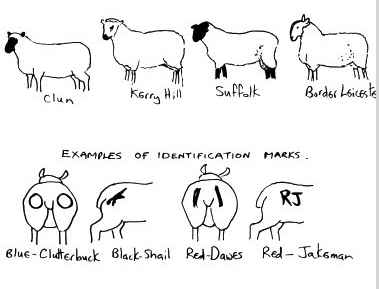THE BCH ARCHIVE
LOCAL HISTORY FOR
BIRTSMORTON
CASTLEMORTON
HOLLYBUSH
And The Surrounding District
CASTLEMORTON COMMON GUIDEBOOK
8. The Farming Year and the Common.
The farms around the common range in size from 6 sons
to 200 acres, and they are all mixed in nature,
producing more than one type of crop. As one would
expect. because of the availablility of the common,
most have sheep and/or cattle. as well as fruit, mainly
damsons, plums, cider apples and perry pears.
The sheep are of several breeds, mainly cross-bred.
with a large proportion of Suffolk blood, as well as
crosses with Welsh, Kerry Hill, Border Leicester, Hill
Radnor etc. The cattle are also nixed with Friesian,
Hereford, Angus and Dairy Shorthorn being well
represented.In winter, as long as the weather is not too had, the
cattle and sheep are turned out on the common to
prevent the poaching up of the in-farm pasture by
trampling. They forage about, finding what they can,
but are brought in at night for feeding in the sheds or
barns.
Some cattle are turned out with their calves. as single
sucklers, and others are brought in at night for
suckling calves kept in sheds on the farms- The calves are sold off, when ready, as store cattle. ie, for fattening up by farmers with more lush land.
The ewes drop their lambs from the end of February
onwards and today most are brought in for lambing, hut
there are still some which give birth on the common - n
rare sight for visitors from town (but, please. from H
distance, and no interference!)
During the winter, hay etc is sometimes put out on the
common during the day to keep the sheep near home. it
is often thrown on the gorse to encourage the animals
to keep it grazed down a bit.
After lambing, the ewes and lambs are turned out on the
common again. during the day, as before. It is usually
about May when a good ‘bite’ develops on the common and
until this time, bringing in at night and feeding close
to home is important to prevent straying.
Shearing and dipping is carried out in early Juno and
most of the lambs are sold, again as store-lambs,
between August and September. Some time after the sale
of the lambs, the ewes go to the ram, or tup. for
mating which is timed as far as possible to produce the lambs after the worst of the winter.
All cattle and sheep on the common are identified with
a mark to show to whom they belong. It is interesting
to the spot the marks, and also useful, as if a local
sees a flock straying through Welland, he knows who to
contact. so they can be brought back quickly.

By Med Snookes
A handbook for Locals and Visitors
